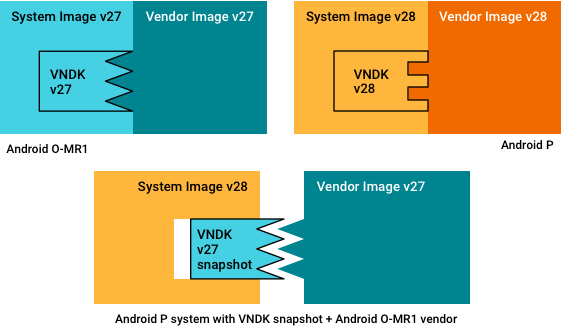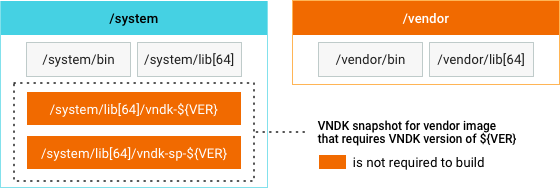VNDK snapshots can be used by a system image to provide the correct VNDK libraries to vendor images even when system and vendor images are built from different versions of Android. Creating a VNDK snapshot requires capturing VNDK libraries as a snapshot and marking them with a version number. The vendor image may link with a specific VNDK version that provides required ABIs for the modules in the vendor image. However, within the same VNDK version, the VNDK libraries must be ABI-stable.
VNDK snapshot design includes methods for generating the pre-builds of a VNDK snapshot from the current system image and installing those pre-built libs to the system partition of a newer Android version.
About VNDK libraries
HIDL-HALs, introduced in Android 8.0, enables separate upgrades for system and vendor partitions. VNDK defines sets of libraries (VNDK-core, VNDK-SP and LL-NDK) that vendor code can link with and blocks the vendors from using libraries that are not in a VNDK set. As a result, the vendor image can be built and run if the proper VNDK sets on the system image are provided to the vendor image.
VNDK-core
The VNDK-core set of libraries is installed in
/system/lib[64]/vndk-${VER} and is available
only for vendor processes with the API level equal to
${VER}. System processes may not use these libraries and must
instead use the libraries installed in /system/lib[64]. Because
of the strict namespace restriction for each process, the VNDK-core libraries
are safe from dual-loading.
To include a library in VNDK-core, add the following to
Android.bp:
vendor_available: true, vndk: { enabled: true, },
VNDK-SP
VNDK-SP libraries are installed in /system/lib[64]/vndk-sp-${VER}
and are available to vendor processes and system processes (through the SP-HAL
libraries installed in vendor partition). VNDK-SP libraries may be
dual-loaded.
To include a library in VNDK-SP, add the following to Android.bp:
vendor_available: true, vndk: { enabled: true, support_system_process: true, },
LL-NDK
LL-NDK libraries are installed in /system/lib[64]. Vendor modules
can use LL-NDK stub libraries to access pre-selected symbols of LL-NDK
libraries. LL-NDK libraries must be backward-compatible and ABI-stable to
enable old versions of vendor modules to use new versions of LL-NDK libraries.
Because of the ABI-stable characteristics of LL-NDK, the VNDK snapshot does
not need to include LL-NDK libraries for old vendor images.
About VNDK snapshots
Android 8.1 included VNDK libraries built from the source code. However, for later versions of Android, each VNDK version must be captured as a snapshot and provided as a pre-build to enabling linking to an older vendor image.
Starting in Android 9, new versions of Android will
include at least one snapshot of VNDK-core and VNDK-SP directories for older
versions in the Android source code. At build time, required snapshots will be
installed to /system/lib[64]/vndk-${VER} and
/system/lib[64]/vndk-sp-${VER} (directories that can be used by
the vendor partition), where ${VER} is the string variable that
represents the version name of the VNDK snapshot.
As the VNDK snapshot libraries may differ for each VNDK version, the VNDK
snapshot also includes the linker namespace configurations, installed as
etc/ld.config.${VER}.txt,
/etc/llndk.libraries.${VER}.txt, and
/etc/vndksp.libraries.${VER}.txt.
Example: Upgrade system and vendor images
No snapshot required; build without additional configurations for VNDK snapshots.
Example: Upgrade system image only
Must include the VNDK snapshot and linker namespace configuration files for
the vendor image in the system image. The linker namespace configuration files
are automatically configured to search for VNDK libraries in
/system/lib[64]/vndk-${VER} and
/system/lib[64]/vndk-sp-${VER}.

Example: Upgrade system image, minor vendor image change
Building a vendor image against a VNDK snapshot is not yet supported, so you must build the vendor image separately with its original source code, then upgrade the system image as described in the previous example.
VNDK snapshot architecture
To make an Android 9 system image compatible with an Android 8.1 vendor image, the VNDK snapshot that matches the Android 8.1 vendor image must be provided with the Android 9 system image, as shown below:

The VNDK snapshot design includes the following methods:
- Generating a snapshot for VNDK-core and VNDK-SP
libraries. Android 9 includes a script you
can use to make a snapshot of the current VNDK build. This script bundles all
libraries in
/system/lib[64]/vndk-28and/system/lib[64]/vndk-sp-28that were built with the current source as a VNDK snapshot, where28is the VNDK version of Android 9. The snapshot also includes the linker namespace configuration files/etc/ld.config.28.txt,/etc/llndk.libraries.28.txt, and/etc/vndksp.libraries.28.txt. The generated snapshot will be used with newer Android versions (higher than Android 9). - Installing pre-built VNDK-core and VNDK-SP libraries from a
snapshot. In Android 9, a VNDK snapshot has
a set of pre-built VNDK-core libraries and a set of VNDK-SP libraries, as well
as linker namespace configuration files. When you provide a list of VNDK
snapshot versions to be installed, at build time, the system image installs
the VNDK snapshot libraries to
/system/lib[64]/vndk-${VER}and the/system/lib[64]/vndk-sp-${VER}directories and linker namespace configuration files for those VNDK snapshots to/etcdirectory.
VNDK versioning
Each Android release has only one VNDK snapshot and the SDK version is used as
a VNDK version (which means the VNDK version has an integer number, such as 27
for Android 8.1). The VNDK version is fixed when the Android version is
released. The VNDK version used by the vendor partition is stored
automatically in the ro.vndk.version property, which can be read
on runtime. This version is then used in identifying the vendor VNDK version
for some libraries and identifying the VNDK snapshot version for namespace
configuration.
Build VNDK libraries
The make vndk command builds libraries that have vndk:
{ enabled: true, … }, including dependencies and namespace
configuration files. If BOARD_VNDK_VERSION := current is set,
these libraries are built with the make command.
Because this build does not install the VNDK libraries from the snapshot, the installed VNDK libraries are not ABI-stable. However, when an Android version is released, the ABI for the current VNDK version is fixed. At this point, any ABI breakage is a build error, so patches to the Android version must not change the ABI for VNDK libraries.
